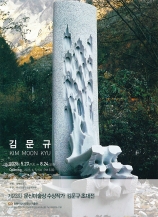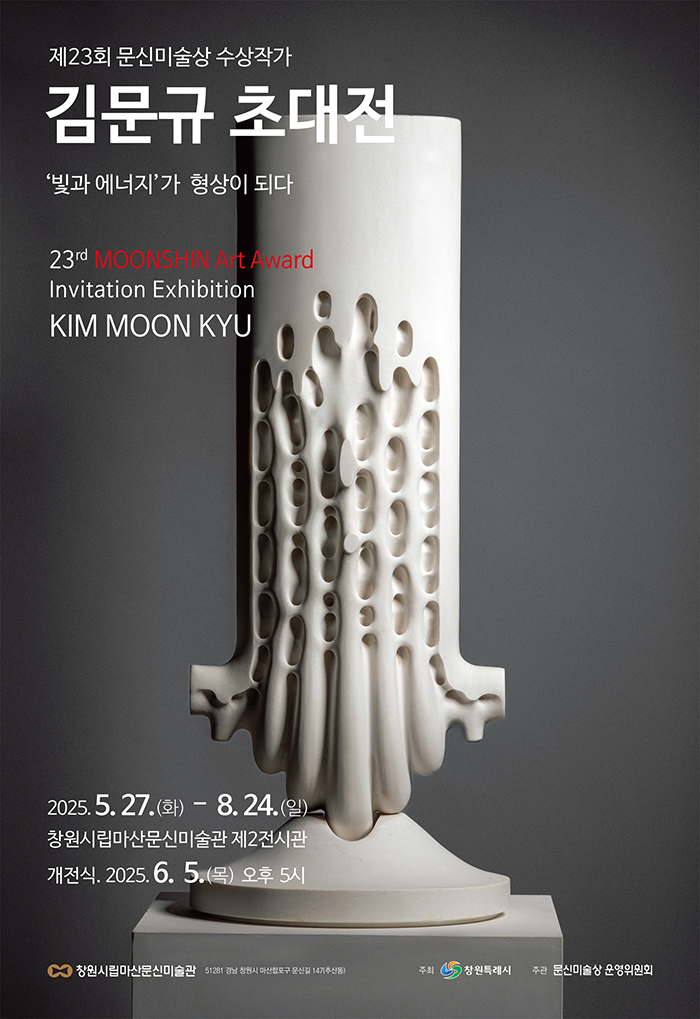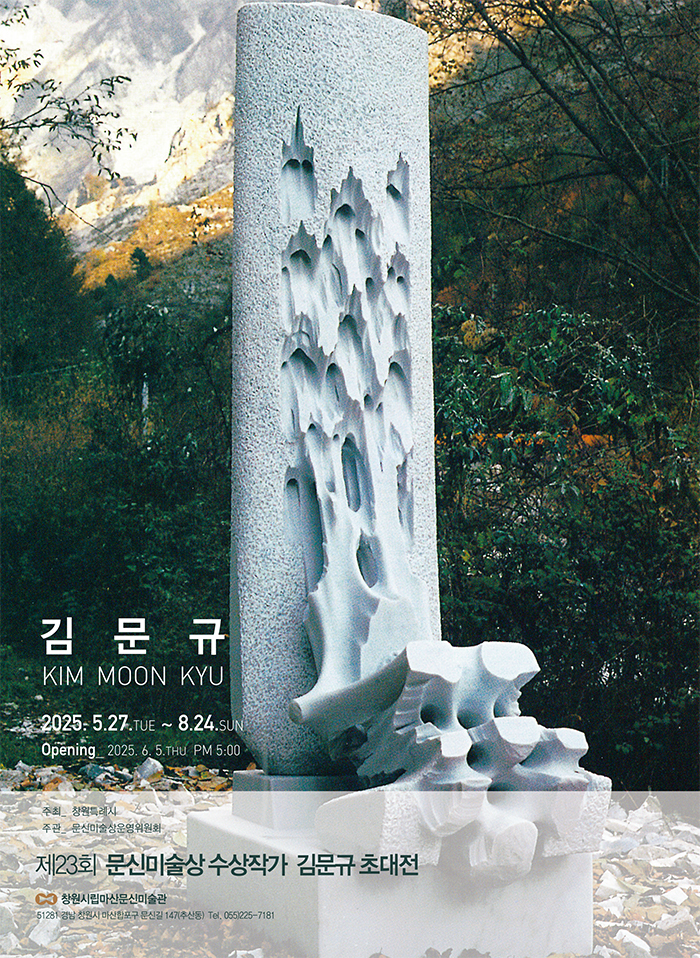김문규의 작품 세계_철학적 사유로서 예술
임민영
미술은 오감(五感)으로 지각할 수 없는 것을 시각 이미지로 전환하는 힘을 가진다. 철학이나 종교처럼 개념으로 존재하지만 직접적으로 인지할 수 없는 것이 있다. 인간은 보고 듣고 만지는 등 신체 자극이 일어날 때 그 존재를 알아차리기 마련이다. 그렇기에 우리는 존재하지만 감각으로 지각할 수 없는 것들을 인지할 수 있는 방법에 대해 고심해 왔다. 예술의 존재 이유 중 하나가 바로 이 때문이다. 시각예술로서 미술은 보거나 만질 수 없지만 존재하는 무엇인가를 시각 대상물로 나타낼 수 있다. 고대 미술에서는 자연에 대한 경외와 죽음 이후 세계에 대한 생각을 회화와 조각으로 나타내었고 중세에는 절대적 존재인 신을 향한 경의를 표현했다. 현대에 이르러 미술은 예술가의 사상과 개념을 표현하기 위한 조형 언어로 역할 한다.
이처럼 미술은 지각할 수 없어도 우리 삶을 지탱하는 중요한 그 무엇을 눈으로 보고 만질 수 있는 형상으로 드러낸다. 미술은 철학과 종교, 인간의 사유와 감정을 비롯하여 감각으로 인지할 수 없으나 분명 존재하는 것을 보이는 것으로 만들어 감상 행위를 통해 읽을 수 있도록 한다. 일례로 로마 베드로 대성당에 자리한 미켈란젤로(Michelangelo Buonarroti)의 <피에타(Pietà)>를 통해 우리는 숭고한 슬픔이라는 개념을 경험할 수 있다. 숭고한 슬픔은 명확한 형태로 존재하거나 그것을 말로 설명할 수 없지만, 우리는 미켈란젤로가 조각한 성모 마리아의 표정을 통해 그 개념을 직관적으로 알아차릴 수 있다.
김문규의 조각은 눈에 보이지 않는 것을 보이는 것으로 전환하는 시각예술이 가진 힘을 내포한다. 그의 작업은 생(Life), 빛(Light) 그리고 에너지(Energe)를 주제로 한다. 이러한 주제는 근원적인 의미를 담고 있는 포용적 개념이다. 생과 빛 그리고 에너지는 인간 삶을 아우르는 만물의 근원을 형성하는 개념으로 추상적이지만 능동적인 기운을 가지고 있다. 명확하게 정해진 의미를 지니거나 고정 불변하는 내용을 담고 있지 않지만 그렇기에 오히려 많은 것을 이야기할 수 있다. 작가가 포용적인 주제를 다루는 것은 삼라만상의 근원에 대한 사유를 위함이다. 고차원적 추상성을 지닌 생과 빛 그리고 에너지는 다양한 깨달음의 가능성을 열어 놓는다. 눈에 보이지 않고 정해진 답이 없는 개념이기에 끊임없이 변화하고 각자 다른 결론에 이르게 한다.
작가는 추상적으로 형상화한 조각을 통해 이러한 주제를 인지할 수 있도록 한다. 이에 대해 그는 ‘미풍(微風)’을 예로 든다. 미풍은 단순히 약하게 부는 바람 그 이상의 섬세한 의미를 담고 있다. 우리는 미풍을 볼 수 없다. 그런데도 그것이 나뭇잎과 나뭇잎 사이를 지나갈 때 일어나는 작은 떨림을 통해 그 존재를 인지할 수 있다. 미풍이 있기에 나뭇잎에 떨림이 일어날 수 있고 나뭇잎의 떨림으로 미풍은 존재할 수 있듯이, 빛이 있기에 우리가 세상을 인지할 수 있고 세상이 있기에 빛이 존재할 수 있다. 생, 빛, 에너지는 삶에 대한 근원적 물음과 그 답을 찾아가는 인생이라는 여정에서 핵심적인 요소로서 작가가 조각적 형상으로 나타내고자 하는 중심 주제다. 작가는 무심히 보는 이에게 내어놓은 듯한 조각 작품을 통해 관람자가 자신을 돌아보고 근원적 질문에 대한 고찰을 향해 나아갈 수 있도록 한다.
《생》 시리즈는 큰 덩어리에서 일부가 분리되어 새로운 덩어리가 탄생하는 듯한 형상이다. 세포가 분열하여 생명이 만들어지는 듯하고 때로는 거대한 나무에서 작은 가지가 나와 생명이 발화하는 듯하다. 또 때로는 알껍데기를 깨고 부화하는 생명체를 연상시키기도 한다. 보는 이에 따라 다양한 해석의 가능성이 열려 있는 추상적 형상이지만 이들에는 공통점이 있다. 마치 모체로부터 분리되어 새로운 형상이 생성되는 이미지를 통해 근원으로부터 새로움이 탄생하는 동적인 형상을 표현하고 있다. 생명의 근간으로부터 발화하는 이미지는 자연물의 탄생을 형상화한다.
《빛》 시리즈에서는 쏟아지고 발산하는 빛의 이미지를 추상적으로 형상화한다. 빛은 식물을 자라게 하고 대기의 순환을 일으키며 자연 만물을 생동하게 하는 에너지다. 나아가 인간에게 초월적인 존재를 향한 경외감을 일으키거나 정신적인 참회와 성찰을 이끌기도 한다. 성당 안으로 쏟아지는 빛을 통해 신의 은총을 느낄 수 있듯이, 빛은 물리적 에너지원을 넘어서 인간에게 정신적 환희를 일으킨다. 이 시리즈에서 작가는 응축되어 발산하는 듯한 빛의 모습, 지면으로 쏟아져 내리는 듯한 빛 이미지를 형상화한다. 작가의 말처럼 빛은 그 자체로 만질 수 없고 우리 눈으로 명확한 형상을 볼 수 없다. 그런데도 빛은 어떤 것을 비춤으로써 그 존재를 드러낸다. 《생》 시리즈가 근원으로부터 생명이 탄생하는 듯한 이미지를 추상적으로 형상화한다면 《빛》 시리즈는 보다 고차원적인 개념으로 존재의 탄생을 담고 있다.
생과 빛을 수렴하는 개념으로서 에너지는 좀 더 높은 차원의 개념으로 완숙기에 이른 작가의 작업에서 주요한 주제이다. 《에너지》 시리즈에서는 응축하고 확산하는 에너지를 추상적으로 형상화한다. 에너지 시리즈 작품은 생과 빛 시리즈에 비해 좀 더 간결하고 선적인 형상으로 조형 작품의 자유로운 동세를 강조한다. 흐르고, 상승하고, 모여드는 듯한 형상을 통해 굴곡과 변곡을 이루며 계속해서 나아가는 에너지를 추상적으로 형상화한다. 이는 생과 빛 시리즈 작업에 비해 훨씬 더 단순해진 형상을 보여주어 단순함이 주는 조형적 시각의 아름다움을 느낄 수 있다.
추상적이고 단순한 형상은 보는 이에게 강한 여운을 남기면서 능동적인 정신 작용을 일으킬 수 있다. 예술이 가진 힘이란 그것을 받아들이는 이의 자발적인 사고 작용이 수반될 때 비로소 완성된다. 작가는 추상적 형상을 ‘그저 거기에 놓음’으로써 보는 이가 스스로 깨달음에 이르도록 한다. 감상자가 능동적 의지를 가지고 작품을 마주하는 경험을 통해 삶에 대해 깨닫고 사유하도록 이끄는 것이 미술 작품이 가진 힘이고 추상의 위대함이다. 감상하는 행위는 작품에 의해 능동적 사고 과정이 일어나 스스로 사유하는 것이다. 그의 작품에서 추상화된 형상들은 이러한 감상 작용을 자연스레 이끌어 낸다.
자연스러움을 추구하는 김문규 작업의 기본 방향성은 작가가 재료를 다루는 과정에서도 드러난다. 나무와 돌을 재료로 하고 최근에는 스테인리스를 비롯한 금속 재료를 주로 사용한다. 그의 돌 조각과 나무 조각은 인위적으로 만들어낸 모습이라기보다는 원래 재료에 내재해 있던 형상이 재료 그 자체의 표면 위로 떠오르도록 한다는 인상을 준다. 근본적인 것으로부터 새로움이 발화하고 빛을 비춤으로써 그 존재가 드러나듯이, 재료 본연의 물성으로부터 형상이 자연스럽게 부상하는 듯한 모습이다. 작가는 오래전부터 목조와 석조 작업을 해 왔다. 나무에 대한 애정으로 시작하여 이탈리아 유학 시기에는 돌에 대한 관심이 깊어졌다. 그리고 작업의 원숙기에 이르러 금속이라는 재료를 더하며 표현 방식을 확장하고 있다.
김문규는 재료를 다루는 뛰어난 기술력을 가진 예술가다. 나무가 가진 따뜻함, 돌의 굳건함, 금속의 매끄러움과 같은 재료의 특성을 기술적으로 완벽에 이르도록 잘 나타낸다. 그런데도 그는 이러한 기술적 능숙함이 순수한 창의성을 해치는 것이 아닌지 자문한다. 이탈리아에서 8년간 돌을 다루었던 경험에 대해 그는 ‘스스로를 발견하는 과정’이라 말한다. 나무를 깎고 돌을 다듬고 스테인리스 표면을 다듬어 재료 본연의 상태에서 형상이 발화하듯이, 원래 그 안에 있던 것이 드러나듯이 자연스러운 모습을 만드는 작업 과정이 작가에게는 스스로 성찰하는 과정일 것이다. 진리는 원래 이 세상에 있는 것인데, 그것을 깨닫는 것은 원래 있던 것을 알아차리고자 하는 우리의 의지다. ‘거기 있음’을 알아가는 과정, 작가에게 작업은 깨달음을 얻기 위해 노력하는 과정이다.
작가의 작업 과정은 일견 수행자의 모습과 닮았다. 거대한 돌을 다듬고 나무를 깎는 일은 육체적으로 쉽지만은 않다. 그런데도 미술가가 그러한 재료를 다루는 것은 창작의 행위가 수행과도 같기 때문이다. 철학자가 사유하고 무용가가 몸짓을 연습하고 음악가가 악기를 다루기 위해 오랜 시간 노력하는 것은 결국 예술은 매체를 통해 수행하는 과정이기 때문이다. 그것이 미술가에게는 재료를 다루고 작품에 스스로의 사유 과정을 담아내기 위하여 노력하는 것이다.
결이 드러나는 나무와 거칠고 매끄러움이 공존하는 돌을 다듬어 빛과 생에 대한 이야기를 담고 있는 형상을 만들어 내었던 작가는 최근에 《에너지》 시리즈에 집중한다. 작가의 작업에서 특히 이 시리즈는 이전 작품에 비해 더욱더 간결한 모습이다. 단순한 곡선의 움직임이 느껴지는 작품에는 ‘비움’의 미학이 담겨 있다. 근본적인 것에 대한 깨달음의 과정이 바로 이 비움으로 귀결한다. 그의 작품은 한 예술가의 끊임없는 정진의 결과물이다. 작가는 창작하며 끊임없이 사유하고 그 결과물에는 연연하지 않아야 한다고 말한다. 그저 자신을 다듬어 가는 과정에서 조형미를 추구하는 것이 예술가가 순수한 창작을 하는 과정이라 말한다.
진정한 대가는 스스로 대가라 하지 않는다. 대가의 삶은 그것을 지켜봐 준 이들이 인정하는 것이다. 그렇기에 대가는 대가가 되려고 애쓰지 않아야 한다. 눈치 보지 않고 자신의 길을 묵묵히 걸어가기에 그 진정성과 정진의 시간을 사람들이 인정한다. 미술가의 삶을 꿋꿋하게 걸어오면서 김문규는 끊임없이 수행자와 같은 태도를 유지하고자 한다.
Kim Moon-kyu’s Artistic World: Art as Philosophical Contemplation
Im Min-young
Art possesses the power to transform what cannot be perceived by the five senses into visual images. Like philosophy or religion, there are things that exist as concepts but cannot be directly recognized. Humans tend to become aware of an existence when physical stimuli such as seeing, hearing, or touching occur. Therefore, we have long pondered how to perceive things that exist but cannot be sensed. One of the reasons for art’s existence lies here. As visual art, fine art can present as visual objects things that cannot be visualized or touched but nonetheless exist. In ancient art, awe of nature and thoughts about the world after death were expressed through painting and sculpture; in the Middle Ages, reverence for the absolute being—God—was depicted. In modern times, art functions as a formative language to express the artist’s thoughts and concepts.
In this way, art reveals in visible and tangible forms the important things that sustain our lives, even if they cannot be perceived. Art makes visible what cannot be sensed—philosophy, religion, human thought and emotion—so that they can be read through the act of appreciation. For example, through Michelangelo Buonarroti’s Pietà at St. Peter’s Basilica in Rome, we can experience the concept of “sublime sorrow.” Sublime sorrow does not exist in a clear form nor can it be explained in words, but we can intuitively grasp the concept through the expression Michelangelo carved on the Virgin Mary’s face.
Kim Moon-kyu’s sculptures embody the power of visual art to make the invisible visible. His work revolves around the themes of Life, Light, and Energy. These themes are inclusive concepts imbued with fundamental meaning. Life, light, and energy are abstract yet dynamic concepts that form the origin of all things encompassing human existence. They do not have fixed or immutable meanings, and precisely for that reason, they can speak of so much more. The artist’s engagement with such inclusive themes is an inquiry into the origins of all things. Life, light, and energy, with their high level of abstraction, open up possibilities for various realizations. Because these concepts are invisible and lack definitive answers, they are in constant flux and lead each person to different conclusions.
The artist enables recognition of these themes through abstractly shaped sculptures. He uses “gentle breeze” as an example. A gentle breeze is more than just a lightly blowing wind; it carries a subtle meaning. We cannot see the gentle breeze, but we recognize its existence through the slight trembling it causes as it passes between leaves. Just as the trembling of leaves reveals the breeze and the breeze exists because it causes the trembling, we perceive the world because there is light, and light exists because there is the world. Life, light, and energy are central themes that the artist seeks to express sculpturally as key elements in the journey of life’s fundamental questions and answers. Through sculptures that seem casually placed before the viewer, the artist encourages self-reflection and contemplation of fundamental questions.
《The Life》 series features forms that appear as if a part has separated from a larger mass to give birth to something new. It evokes the division of cells to create life, or the sprouting of a small branch from a giant tree, or even a creature hatching from an eggshell. Though the abstract forms allow for various interpretations, they share a commonality: through images of new forms emerging from a source, they express the dynamic birth of newness from the origin. The imagery of life sprouting from its foundation is a visualization of the birth of natural objects.
《The Light》 series abstractly shapes the image of pouring and radiating light. Light is the energy that makes plants grow, circulates the atmosphere, and animates all of nature. Moreover, it can evoke awe toward a transcendent being or inspire spiritual reflection and repentance in humans. Just as one can feel divine grace through light pouring into a cathedral, light, beyond being a physical energy source, brings about spiritual ecstasy. In this series, the artist shapes light as if it is condensed and radiating, or pouring down onto the ground. As the artist notes, light itself cannot be touched or clearly seen, yet it reveals its existence by illuminating something. If the Life series abstractly visualizes the birth of life from its origin, the Light series contains the birth of existence as a higher-level concept.
As a concept that encompasses life and light, energy becomes a major theme in the artist’s mature works. The Energy series abstractly shapes the condensation and diffusion of energy. Compared to the life and light series, these works are simpler and more linear, emphasizing the free movement of sculptural forms. Through shapes that flow, rise, and gather, the artist abstractly expresses energy that continues to move through undulations and inflections. The forms in this series are much simpler, allowing one to feel the visual beauty that simplicity brings.
Abstract and simple forms leave a strong impression and can trigger active mental engagement in the viewer. The power of art is fully realized only when it is accompanied by the recipient’s voluntary thought process. The artist “just places” the abstract forms, allowing the viewer to reach realization on their own. Through the active experience of confronting the work, the viewer is led to contemplate and realize truths about life—this is the power of art and the greatness of abstraction. The act of appreciation is an active mental process induced by the artwork, leading to self-reflection. The abstract forms in his works naturally elicit this process.
Kim Moon-kyu’s pursuit of naturalness is evident in his handling of materials. He uses wood and stone, and more recently, metals such as stainless steel. His stone and wood sculptures seem less artificially made and more as if the inherent forms within the materials have surfaced. Just as newness springs from the fundamental and existence is revealed by the shining of light, the forms appear to emerge naturally from the material’s inherent properties. The artist has long worked with wood and stone, beginning with a love for wood and, during his studies in Italy, developing a deep interest in stone. In his mature period, he has expanded his expressive methods by incorporating metal.
Kim Moon-kyu is an artist with outstanding technical skill in handling materials. He perfectly brings out the warmth of wood, the solidity of stone, and the smoothness of metal. Yet, he questions whether such technical mastery might undermine pure creativity. Of his eight years working with stone in Italy, he says it was “a process of discovering myself.” Carving wood, shaping stone, and polishing stainless steel to bring out forms as if they emerge from the material itself is, for the artist, a process of self-reflection. Truth already exists in the world; realizing it is our will to recognize what is already there. The process of “becoming aware of what is there”—for the artist, creation is a process of striving for enlightenment.
The artist’s working process resembles that of an ascetic. Shaping massive stones and carving wood is physically demanding, yet artists engage with such materials because the act of creation is akin to spiritual practice. Just as a philosopher contemplates, a dancer practices movements, or a musician spends years mastering an instrument, art is a process of discipline through a medium. For the artist, this means working with materials and striving to embody his thought process in his work.
Having created forms that tell stories of light and life through the grain of wood and the coexistence of roughness and smoothness in stone, the artist now focuses on the Energy series. This series is even simpler than previous works. The movement of simple curves in the pieces embodies the aesthetics of “emptiness.” The process of realization about the fundamental leads to this emptiness. His works are the result of an artist’s ceaseless striving. He says that in creating, one must continually contemplate and not be attached to the results. Pursuing formal beauty in the process of refining oneself is, for him, the path of pure creation.
A true master never calls themselves a master. The life of a master is acknowledged by those who observe it. Therefore, a master should not strive to become one. It is the sincerity and perseverance of quietly walking one’s own path, without regard for others’ opinions, that people recognize as genuine. Kim Moon-kyu, steadfastly walking the path of an artist, seeks to maintain the attitude of an ascetic.
金文奎的作品世界_作为哲学思考的艺术
林敏英
美术拥有一种独特的力量,能够将五感无法触及的存在,转化为视觉化图像。如哲学或宗教以概念形式存在、却无法直接感知。人类往往需要通过视觉、听觉或触觉等身体感官的刺激,方能察觉它的存在。因此, 我们一直在苦思并寻找如何识别虽然存在,但无法感官可感知到的事物的方法。艺术正是在回应这一命题,找到自身存在的意义。作为视觉艺术形式的美术,能够赋予不可见、不可触的存在形象,让其成为视觉可感的对象。在古代,美术借助绘画与雕塑,表现对自然的敬畏与对死后世界的遐想;在中世纪,则以图像形式,表达对至高神明的信仰与尊崇。进入现代,美术进一步演变为表达艺术家思想与理念的造型语言,成为观念与精神的具体呈现方式。
正如前文所述,美术能够赋形于那些无法被五感感知、却深刻支撑着我们生命的存在,使它们以可见、可触的形象呈现在我们眼前。它将哲学、宗教,以及人类的思维与情感等,虽无法用感官捕捉却真实存在的事物,转化为可感知的形式,让观者在欣赏中得以阅读和领悟。例如,透过安放于罗马圣彼得大教堂的米开朗基罗(Michelangelo Buonarroti)雕塑作品《哀悼基督》(Pietà),我们能够真切体验“崇高的悲伤”这一抽象概念。崇高的悲伤并无明确形态,也难以用语言加以界定,但当我们注视米开朗基罗所刻画的圣母玛利亚的神情时,这种情感便不言自明地直抵人心—一种超越语言、直观可感的精神触动。
金文奎的雕塑作品,深藏着视觉艺术将无形之物具象化的力量。他以“生命(Life)”、“光(Light)”与“能量(Energy)”为创作核心,这些主题作为包容性的观念,蕴含着对本源的深刻思索。生命、光与能量不仅是构成人类生活全貌的根基元素,更是贯穿宇宙万象的抽象存在,它们虽不可见,却涌动着活跃而积极的气息。这些概念没有固定的定义,也非恒常不变的真理,正因其开放性,使得艺术家得以用它们讲述更为丰富的内在世界。艺术家选择包容性的主题,正是为了触及万物起源的哲学思考。作为高度抽象却又能量十足的存在,生命、光与能量为多种层次的领悟开启了无限可能。它们没有确定的形态,也无终极答案,因此始终处于不断生成与变化之中,引导每一位观者走向各自不同的理解与回应。
艺术家通过抽象的雕塑语言,使人得以感知那些本不可见的主题。他以“微风”为例,阐明这一转化的可能性。微风,并非只是轻轻拂过的空气流动,它蕴藏着更为细腻、难以言传的意味。我们无法用肉眼看见微风,但当它掠过树叶之间,带来轻微的颤动时,那一刻,我们便感受到它的存在。正如因微风而起的叶动使我们察觉风的存在,世界的感知亦需借助于光,而正是因为世界的存在,光才被赋予意义。生命、光与能量,是艺术家以雕塑语言不断探索与呈现的核心主题,它们构成了人在生命旅程中不断追问本源与意义的关键线索。艺术家将这些作品若无其事地摆放在观者面前,仿佛轻描淡写地呈现出来,却正是邀请观者驻足凝视,回望自我,在静默中迈向对存在之问的深入探究。
《生》系列作品以抽象的形态展现出一种动态的生命诞生图景——仿佛从巨大块体中裂解而出的一部分,演化为全新的存在。这一形象,既像细胞在分裂中孕育生命,又似参天古木上抽出的新枝,轻轻一点,便点燃了生的火种;有时,它甚至唤起人们对破壳而出、迎向世界的生命体的联想。尽管这些作品为观者展开了多重诠释的可能,但其核心却指向同一源点:以“自本源中诞生新生”的动势,构建一种从母体分离、持续生成的视觉隐喻。那从生命根基中发出的形象,不仅再现了自然万物的诞生,也引导我们直面生命的本质——那不可见却始终在场的生成之力。
《光》系列以抽象造型呈现光线倾泻、汇聚与绽放的形象。光,是使植物萌芽、大气流转、万物跃动的生命之源;更是唤起人类对超越存在的敬畏,引导精神沉潜与自省的力量。正如阳光穿透教堂高窗倾泻而下时,人们在光中感受到神的恩典,光超越了物理形式,成为一种精神的喜悦与感召。在这一系列中,艺术家以视觉语言描绘出凝聚之后即将爆发的光的能量,亦或似瀑布般洒落于地的瞬间。正如他所言:光无法触摸,也难以用肉眼捕捉其确切形态,但正因为它照亮万物,才显露出自身的存在。若说《生》系列描绘的是生命从根源中诞生的图景,那么《光》系列则更进一步,承载着关于“存在如何生成”的哲学命题,以一种更高维度的意象语言,引领观者探问存在的本质与精神的起点。
作为“生命”与“光”的汇聚与升华,能量构成了艺术家进入创作成熟期后所探究的核心主题。《能量》系列以抽象造型呈现能量的凝聚与扩张,那是一种不被束缚的流动之力,一种在看似无形中却拥有强烈存在感的动态本质。相较《生》《光》系列,这一系列作品在形式上更趋简洁,线条化的造型语言凸显了作品中自由而流畅的动势。艺术家以流动、上升、汇聚的形象隐喻能量的运行轨迹——它在起伏、转折中持续推进,生生不息。正是这份极简的美学策略,让观者在简练的造型中感受到能量最本质的律动与生命力,使“简”不仅成为形式的选择,也成为表现张力与哲思深度的手段。
抽象而纯粹的形象,往往比具象更能触及人心深处。它们以最少的线索,唤起观者内在最丰沛的感知与想象,在沉默中留下悠长的余韵。艺术的力量,唯有当它激发出观者自主思考与感应时,方能真正实现其完整的意义。艺术家选择将抽象形象“自然地置于其所”,正是希望观者能在无引导的直面中,自行触发领悟。在观看与凝视之间,那些看似平静的形象悄然唤起深层的情绪与思维,让人以自己的方式回应作品。观看因此不再是被动的接受,而成为一种由内而发的思索过程,是自我意识与作品之间的对话。他的作品中所蕴含的抽象性,不仅给予了观者诠释的自由,也激发了自我省思的深度——这正是抽象艺术真正伟大的地方。
金文奎的创作理念,始终追求自然与和谐,这一理念在他对材料的处理过程中展现得淋漓尽致。他的雕塑作品主要以木材和石材为主,近年来,他也开始探索不锈钢等金属材料的表现潜力。他的木雕与石雕作品给人一种深刻的印象,这些形象并非经过人为雕刻而成,而是仿佛从原材料本身的内在特性中自然升起,仿佛它们本来就蕴藏在材质的表面之下。正如生命从根源中诞生、从黑暗中被光明照亮并最终显现其真实存在一样,这些雕塑的形态似乎也自然而然地从材料的本质中浮现而出。金文奎的雕塑作品,始终以材料的本质为基础,去展现其最自然的形态。金文奎自早期便深入从事木雕和石雕创作,最初源于他对木材的深厚情感,而在意大利留学期间,他对石材的兴趣也愈发浓厚。随着创作经验的积累和技艺的成熟,他的艺术表现形式不断拓展,如今,金属材料也成为了他作品的重要组成部分,赋予了他雕塑更加丰富和多元的语言。
金文奎是一位在材料处理上具有卓越技艺的艺术家,他能够将木材的温暖、石材的坚韧以及金属的光滑等材质特性完美地呈现。然而,他也时常自问,这种技术上的熟练是否会限制了他作品中纯粹创意的发挥。回顾他在意大利八年的石材创作经历,他将其称为“发现自我的过程”。通过雕刻木材、打磨石材、精细抛光不锈钢表面,材料本身所蕴藏的形态仿佛自然而然地浮现出来。这一创作过程,对金文奎来说,也是一种自我反省的过程。他认为,真理原本就存在于这个世界,而我们能够意识到它,是因为我们有意愿去识别和接纳那些本来就存在的事物。对他而言,创作不仅仅是技术的呈现,更是通过感知去探索和接近真理的过程。
艺术家的创作过程在某种程度上与修行者的过程有着相似之处。雕刻巨大石块、处理木材的工作虽然并不轻松,但艺术家之所以要与这些材料打交道,是因为创作行为本身就像是一种修行。就像哲学家通过思考、舞蹈家通过肢体练习、音乐家通过操练乐器,他们的努力最终都是为了通过各自的媒介进行艺术的“修行”。对艺术家而言,这个过程意味着通过对材料的巧妙运用,将个人的思考与创作过程自然地融入到作品当中,从而不断推动自我成长和创作的深度。
艺术家通过雕刻出展现木材自然纹理与石材粗糙与光滑并存的作品,讲述着光与生命的故事,而最近他则将创作重点转向了《能量》系列。在这系列作品中,艺术家呈现出了与以往作品相比更加简洁的形态。简洁的曲线动势在作品中传达了一种“空灵”的美学。这一切关于根本觉悟的过程,最终都汇聚成这种“空灵”。他的作品是艺术家不断精进与自我探索的成果。艺术家在创作过程中不断进行思考,并强调不应对作品的最终结果产生过多执着。他认为,真正的艺术创作过程,是在不断雕琢自我、追求创作美学的过程中实现的。
真正的大师并不自称为“大师”。大师的生活是由旁观者的认同所奠定的。因此,真正的大师不应刻意去追求这一身份。正因为他不拘泥于外界的眼光,默默走自己的道路,才能赢得人们对他真诚与精进过程的认可。作为一名艺术家,金文奎始终坚持着如修行者般的态度,坚定不移地走自己的艺术之路。



